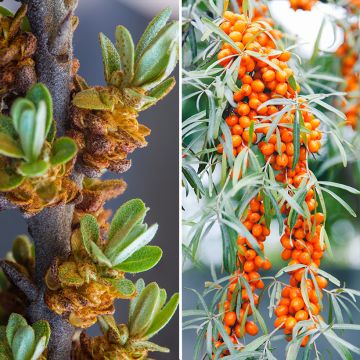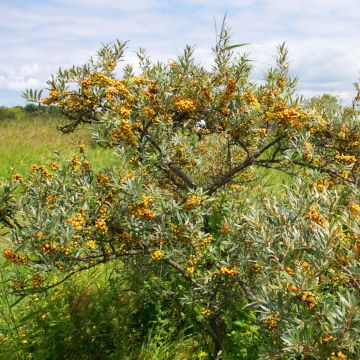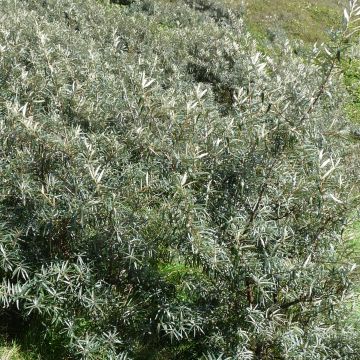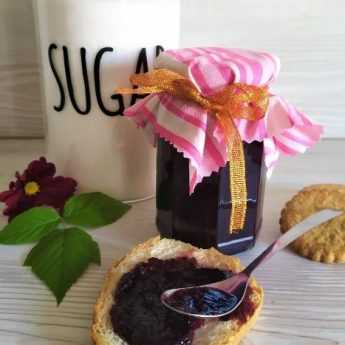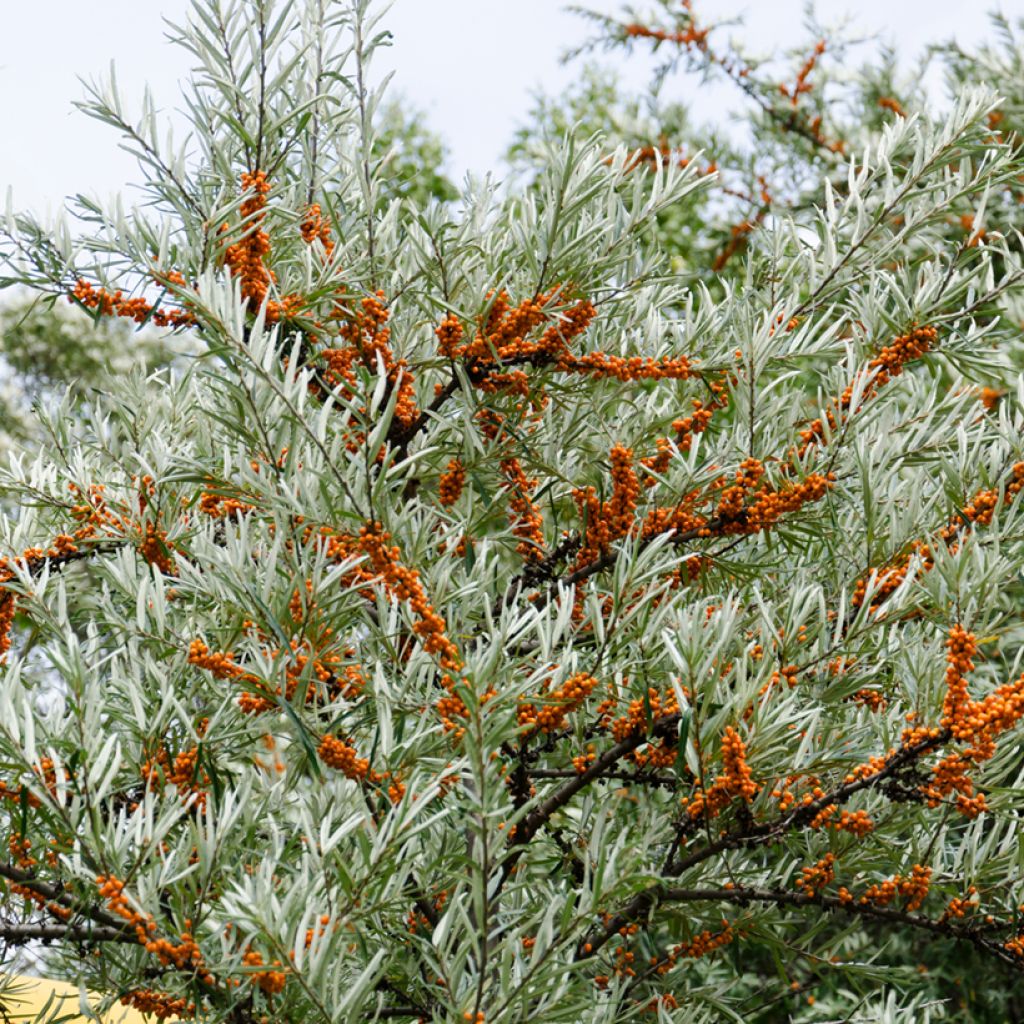

Hippophae rhamnoides Hergo - Sea buckthorn
Hippophae rhamnoides Hergo - Sea buckthorn
Hippophae rhamnoides Hergo
Sea buckthorn, Sallow thorn.
Why not try an alternative variety in stock?
View all →This plant carries a 24 months recovery warranty
More information
We guarantee the quality of our plants for a full growing cycle, and will replace at our expense any plant that fails to recover under normal climatic and planting conditions.
Does this plant fit my garden?
Set up your Plantfit profile →
Description
The female Sea Buckthorn 'Hergo' is a variety of medium to strong vigour that reliably produces, earlier than 'Leikora'. Its medium-sized, yellow-orange fruits ripen from September onwards. Its highly decorative berries are rich in vitamins C, A and E, carotenoids, flavonoids, and oil. Jams, jellies, syrups, and even sauces can be made from them. The bush is very hardy and tolerates poor soils as well as very cold winters. Incorporate it into an informal or defensive hedge not far from a male variety such as Pollmix.
Sea Buckthorn is a member of the Elaeagnaceae family known as Thorny Willow, Siberian Olive, False Buckthorn, and many other names depending on the region. It is native to temperate zones of Europe and Asia. In the wild, it forms a very thorny bush, reaching up to 5 m in height, or even more. It is a pioneering plant, able to grow on mountainsides as well as in dunes. Nodules containing nitrogen-fixing bacteria develop on its roots, indicating excellent adaptation to poor soils. Apart from a few self-fertile varieties, sea buckthorn bears either male flowers or female flowers. It is a dioecious plant. Pollination is carried out by insects. One male plant can pollinate five to six female plants. Female bushes start bearing fruit from the 2nd or 3rd year.
Hippophae rhamnoides 'Hergo' has an arching habit, it is a fast-growing bush reaching a height of 2.5 to 4 m with a spread of 1.5 to 2.5 m. Its deciduous leaves are long and narrow, dark green on top, with a silvery-grey hue underneath. Flowering, which occurs in March-April, is discreet with pale yellowish-white flowers. The yellow-orange fruits, measuring 6 to 8 mm in length, are harvested from September to December. These tangy fruits are rich in vitamin C. They can be used fresh, in jam, jelly, or juice. This bush is extremely hardy (to -30°C), adapts to most soils, even poor and dry ones, and prefers full sun.
The female sea buckthorn 'Hergo' can be planted in groups or in an informal hedge. It fits perfectly in a natural garden. Its tolerance to salty soils and sea spray makes it particularly suitable for coastal areas. It can be associated with tamarisks with Pittosporum tobira and with osmanthus (Osmanthus heterophyllus). Add a male sea buckthorn for pollination.
Report an error about the product description
Plant habit
Flowering
Foliage
Botanical data
Hippophae
rhamnoides
Hergo
Elaeagnaceae
Sea buckthorn, Sallow thorn.
Cultivar or hybrid
Other Hippophae
View all →Planting and care
Sea buckthorn 'Hergo' is best planted in autumn or alternatively in early spring. Choose a very sunny location. Sea buckthorn tolerates all types of soil and will thrive in ordinary or even poor soils. Soak the root ball in water for a quarter of an hour before planting. Dig a wide and deep hole. Position the top of the root ball level with the soil and backfill with soil. Water at the time of planting. If you plant in autumn and it rains from time to time, further watering will not be necessary. Somewhat sensitive to summer drought in its young years, it becomes drought-tolerant once deeply rooted.
Robust, not very susceptible to diseases and pests, sea buckthorn does not require any special care.
Planting period
Intended location
Care
Planting & care advice
This item has not been reviewed yet - be the first to leave a review about it.
Similar products
Haven't found what you were looking for?
Hardiness is the lowest winter temperature a plant can endure without suffering serious damage or even dying. However, hardiness is affected by location (a sheltered area, such as a patio), protection (winter cover) and soil type (hardiness is improved by well-drained soil).

Photo Sharing Terms & Conditions
In order to encourage gardeners to interact and share their experiences, Promesse de fleurs offers various media enabling content to be uploaded onto its Site - in particular via the ‘Photo sharing’ module.
The User agrees to refrain from:
- Posting any content that is illegal, prejudicial, insulting, racist, inciteful to hatred, revisionist, contrary to public decency, that infringes on privacy or on the privacy rights of third parties, in particular the publicity rights of persons and goods, intellectual property rights, or the right to privacy.
- Submitting content on behalf of a third party;
- Impersonate the identity of a third party and/or publish any personal information about a third party;
In general, the User undertakes to refrain from any unethical behaviour.
All Content (in particular text, comments, files, images, photos, videos, creative works, etc.), which may be subject to property or intellectual property rights, image or other private rights, shall remain the property of the User, subject to the limited rights granted by the terms of the licence granted by Promesse de fleurs as stated below. Users are at liberty to publish or not to publish such Content on the Site, notably via the ‘Photo Sharing’ facility, and accept that this Content shall be made public and freely accessible, notably on the Internet.
Users further acknowledge, undertake to have ,and guarantee that they hold all necessary rights and permissions to publish such material on the Site, in particular with regard to the legislation in force pertaining to any privacy, property, intellectual property, image, or contractual rights, or rights of any other nature. By publishing such Content on the Site, Users acknowledge accepting full liability as publishers of the Content within the meaning of the law, and grant Promesse de fleurs, free of charge, an inclusive, worldwide licence for the said Content for the entire duration of its publication, including all reproduction, representation, up/downloading, displaying, performing, transmission, and storage rights.
Users also grant permission for their name to be linked to the Content and accept that this link may not always be made available.
By engaging in posting material, Users consent to their Content becoming automatically accessible on the Internet, in particular on other sites and/or blogs and/or web pages of the Promesse de fleurs site, including in particular social pages and the Promesse de fleurs catalogue.
Users may secure the removal of entrusted content free of charge by issuing a simple request via our contact form.
The flowering period indicated on our website applies to countries and regions located in USDA zone 8 (France, the United Kingdom, Ireland, the Netherlands, etc.)
It will vary according to where you live:
- In zones 9 to 10 (Italy, Spain, Greece, etc.), flowering will occur about 2 to 4 weeks earlier.
- In zones 6 to 7 (Germany, Poland, Slovenia, and lower mountainous regions), flowering will be delayed by 2 to 3 weeks.
- In zone 5 (Central Europe, Scandinavia), blooming will be delayed by 3 to 5 weeks.
In temperate climates, pruning of spring-flowering shrubs (forsythia, spireas, etc.) should be done just after flowering.
Pruning of summer-flowering shrubs (Indian Lilac, Perovskia, etc.) can be done in winter or spring.
In cold regions as well as with frost-sensitive plants, avoid pruning too early when severe frosts may still occur.
The planting period indicated on our website applies to countries and regions located in USDA zone 8 (France, United Kingdom, Ireland, Netherlands).
It will vary according to where you live:
- In Mediterranean zones (Marseille, Madrid, Milan, etc.), autumn and winter are the best planting periods.
- In continental zones (Strasbourg, Munich, Vienna, etc.), delay planting by 2 to 3 weeks in spring and bring it forward by 2 to 4 weeks in autumn.
- In mountainous regions (the Alps, Pyrenees, Carpathians, etc.), it is best to plant in late spring (May-June) or late summer (August-September).
The harvesting period indicated on our website applies to countries and regions in USDA zone 8 (France, England, Ireland, the Netherlands).
In colder areas (Scandinavia, Poland, Austria...) fruit and vegetable harvests are likely to be delayed by 3-4 weeks.
In warmer areas (Italy, Spain, Greece, etc.), harvesting will probably take place earlier, depending on weather conditions.
The sowing periods indicated on our website apply to countries and regions within USDA Zone 8 (France, UK, Ireland, Netherlands).
In colder areas (Scandinavia, Poland, Austria...), delay any outdoor sowing by 3-4 weeks, or sow under glass.
In warmer climes (Italy, Spain, Greece, etc.), bring outdoor sowing forward by a few weeks.



































